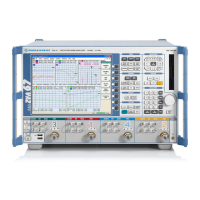Preparing the Analyzer for Use
R&S
®
ZVA
19Getting Started 1145.1090.62 ─ 13
●
All fan openings including the rear panel perforations must be unobstructed. The
distance to the wall should be at least 10 cm.
Electrostatic discharge
To avoid damage of electronic components of the DUT and the analyzer, the operating
site must be protected against electrostatic discharge (ESD). ESD is most likely to
occur when you connect or disconnect a DUT or test fixture to the analyzer's test ports.
To prevent ESD damage use the wrist strap and grounding cord supplied with the
instrument and connect yourself to the GND connector at the front panel.
1.3.3 Bench Top Operation
If the analyzer is operated on a bench top, the surface should be flat. The instrument
can be used in horizontal position, standing on its feet, or with the support feet on the
bottom extended.
Danger of injury
The feet may fold in if they are not folded out completely or if the instrument is shifted.
The feet may break if they are overloaded. Fold the feet completely in or completely
out to ensure stability of the instrument and personal safety. To avoid injuries, never
shift the instrument when its feet are folded out.
The overall load (the instrument's own weight plus that of the instruments stacked on
top of it) on the folded-out feet must not exceed 500 N.
Place the instrument on a stable surface. Secure the instruments stacked on top of it
against slipping (e.g. by locking their feet on the top front frame). When the instrument
is standing on its folded-out feet, do not work under the instrument and do not put any-
thing under it, otherwise injuries or material damage could occur.
The instrument can be used in each of the positions shown here.
Putting the Analyzer into Operation

